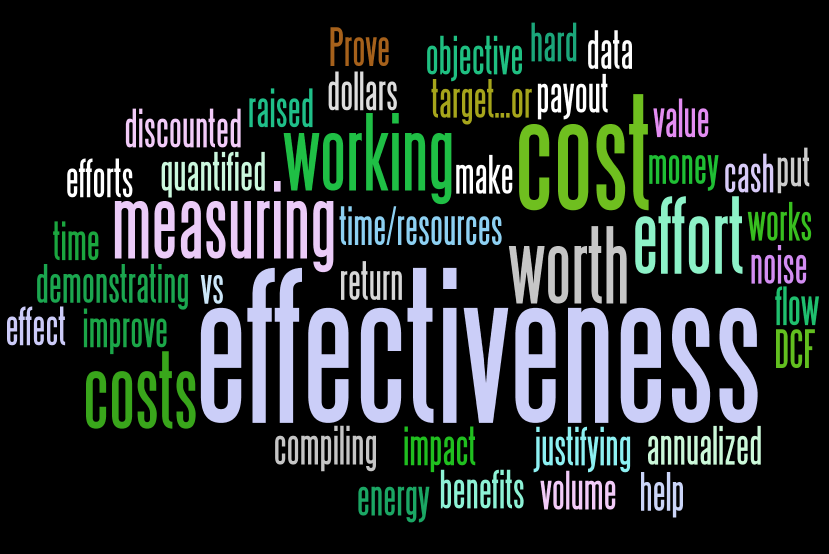 What are your thoughts on what might be trending for 2014? I think that getting your content in front of the right people is the most important of the seven listed in this article. This is what will ultimately lead to more conversions and as a result be much more cost effective.
What are your thoughts on what might be trending for 2014? I think that getting your content in front of the right people is the most important of the seven listed in this article. This is what will ultimately lead to more conversions and as a result be much more cost effective.After all converting leads to sales is what it all boils down to. But in the end a mix of all of these things are important from concerns over privacy that could affect data collection and its use to how to engage those leads in order to be able to target the right ones who show the most promise of converting
.
One important item I feel that was left out is the impact that onsite communities can have in fostering brand ambassadors out of existing customers and employees. All studies show that recommendations and referrals (WOM) has by far the biggest impact in marketing.
William Cosgrove
2014 should be a very interesting year in digital marketing. Businesses are beginning to show more mature digital mindsets which are driving their agencies towards innovation, new media platforms are changing the landscape and the past few years of experimentation should lean toward major advancements and changes in effective digital communication. In my research I have found the following trends that should become evident in 2014.
1. The rise of short video
People hate wasting time. I find myself, like many others, looking at the length of the video before deciding to watch it. Anything more than three minutes and I am not usually interested.
Short video is making waves in the marketing world with popular networks like Vine building around the concept. Instagram’s video upload has added popularity to this trends and brands are already experimenting with video to share brand experiences. Check out the Yuppiechef Instagram profile to see how they are using video to let customers into the everyday life of their business.
A great educational YouTube channel is Minute Physics, which shares physics lessons in one minute. With a little over 2-million views it’s proving a very successful education channel.
2. B2B will find more success through education rather than conversation
In the past B2C (business to consumer) companies have had success in social media channels by creating conversation and inviting the consumers to join them. B2B (business to business) organisations saw this success and decided to adopt the same strategy.
Over the past few years B2B organisations are maturing in their understanding of their social analytics and are realising that conversation is possible in their industries but not necessarily the most valuable marketing component.
In 2014 we will see more B2B organisation move towards education strategies instead of conversation strategies. Educating customers on the value and potential of their services.
3. Content marketing becomes more targeted
A recent article by Forrester analyst Ryan Skinner reveals how distribution, and specifically earned media, is a core component to successful content marketing.
The basic truth is that marketers are asking the wrong question. If you want to know ho two create better content, the question should be “how do I get my content in front of the right people?â€
“As organizations continue to focus on using paid, owned and earned media to increase branded content distribution, social media can be used as a support mechanism to enhance distribution to relevant audiences on social media. Brands that enhance paid and earned media campaigns by distributing this content to relevant audiences on social networks can develop an edge in their respective industries,†says Skinner.
4. Digital agencies will need to prioritise innovation
Doing business today has highlighted the important need for all businesses to begin building their own digital business resources in order to compete in the digital world. Many services that digital agencies provide their clients will move in house leaving digital agencies in a state of necessary restructuring and innovation.
The role of the digital agency will change from providing operational services in the marketing world to providing strategy, innovation and creative skills to the industry. This will see the digital agency world mature and help their clients mature in building their digital competency.
5. Social media data collection will come under scrutiny
Many social media campaigns focus on the collection and use of personal data. In South Africa the POPI Act (Protection of Personal Information) will come into play in 2014 and change the way in which this data can be used and reused. In the same light as developed economies, business in developing economies who process personal information will be highlighted and scrutinised.
6. Social marketing will combine real world and online world
Designing a social campaign means to provide the key elements of personalisation, consumer voice and community. It will become a key success for marketers to focus on designing combined physical and digital experiences in order to create moments of serendipity for the clients and consumers. Fantastic examples of this are Coca Cola’s Share a Coke campaign, fashion retailer Urban Hilton Weiner’s ‘pay with a selfie’ campaign and Carling Black Label’s interactive taste challenge.
7. Smartphone apps will mature
In the past few years smartphone apps have been digital replications of existing business services. In 2014 we should see a move towards businesses using mobile platforms to deliver new services to the market. Leading the way in South Africa is health insurer Discovery with its HealthID app, which combines the power of big data and mobile delivery.
By Mike Saunders
 Many sales people are familiar with the concept of the “sales funnel,†with the idea that every sale starts with a large pool of prospects. Then they are eventually narrowed down by the various steps of the sales process (qualification, presentations, proposals, etc.) leading to a much smaller number of customers who actually decide to buy and close the deal.
Many sales people are familiar with the concept of the “sales funnel,†with the idea that every sale starts with a large pool of prospects. Then they are eventually narrowed down by the various steps of the sales process (qualification, presentations, proposals, etc.) leading to a much smaller number of customers who actually decide to buy and close the deal.
A big part of success in managing your sales leads is developing a better way to understand how you should be managing your sales funnel.
Below are a few of the biggest mistakes that small business leaders tend to make in managing their sales funnels – and ideas on how you can get better results.
Managing Your Sales Funnel Mistake #1:
No Balance Between Lead Generation / Lead Management
Many companies make the mistake of thinking that they can get better sales results just by constantly engaging in lead generation activities to “dump more leads into the funnel.†But lead generation alone is not enough.
You also need to focus on your lead management activities:
- Ranking
- Sorting
- Nurturing
- Following up on your existing sales leads
You can almost always improve your sales results by doing a better job of managing the sales leads you already have. Instead of constantly hunting for more and more sales leads.
Mistake #2:
Focusing on CRM Technology Instead of Your Sales Process
Many small businesses make the mistake of investing in expensive customer relationship management (CRM) software but without a clear understanding of how they want to use the CRM software to improve their sales process.
CRM technology can be a valuable tool, but it cannot replace a smart strategy for understanding and adjusting your sales activities to line up with your biggest priorities in your sales process.
For example, you as a small business leader, need to understand what is happening at every stage of your sales process. Are you failing to generate enough appointments during your initial contacts with new sales leads? Are your sales appointments failing to result in enough follow-up sales presentations? Where in the sales process are you having the most difficulty, and what can you do differently?
These are the questions that CRM tools can help you answer. But you can’t rely solely on technology to do the hard work of identifying and fixing the problems.
Mistake #3:
Not Getting Proper Sales Training
Sales training is not just for new hires. Small business owners need motivation, coaching and a clear idea of what they’re selling and how to adjust to customers’ changing needs and expectations..
Mistake #4:
Not Measuring Each Stage of Your Sales Funnel
Many organizations focus too much on their final deal closing ratios, and don’t pay enough attention to the conversion ratios that lead up to the final negotiations with the buyer.
Take a look at all stages of your sales process and measure your success rate at each stage. For example, out of 100 sales leads, how many will agree to an initial appointment? How many of those appointments lead to a more extensive sales presentation? Where in your sales process are the biggest successes and the biggest opportunities to improve?
Managing your sales funnel needs to be part of an ongoing effort to see what is happening within your sales process and adjusting along the way.
If you have a clear understanding of where your challenges are coming from, which parts of the process need to improve, and constantly coach your sales team to improve their efforts at each stage of your sales funnel, you will start to see a better result in the most important number of all – sales.
By Al Davidson
Â
Sales Funnel Photo via Shutterstock
Â
 The three little words “return on investment†may be the stuff of every marketers’ dreams or nightmares, depending on how their campaigns and initiatives are performing. Every company has limited resources and in order to justify continued expenses and expenditures, marketers are increasingly pressured to provide a reason, through excellent ROI, to keep or increase their budgets. In fact, nearly two-thirds of CMOs believe that ROI will be the principal measure of performance by 2015.
The three little words “return on investment†may be the stuff of every marketers’ dreams or nightmares, depending on how their campaigns and initiatives are performing. Every company has limited resources and in order to justify continued expenses and expenditures, marketers are increasingly pressured to provide a reason, through excellent ROI, to keep or increase their budgets. In fact, nearly two-thirds of CMOs believe that ROI will be the principal measure of performance by 2015.
As many marketing initiatives increasingly position themselves online, where clicks, conversions, traffic, purchases and other deliverables can be easily measured, ROI will grow as a primary means of measurement for marketing. Additionally, this numbers-driven “yardstick,†gives marketing executives the opportunity to provide hard numbers and data when competing against other departments for budgetary funding. Marketing budgets are often the first ones cut since there previously was no way to see how efforts and initiatives were affecting the bottom line. ROI helps combat that lack of awareness.
Marketing campaigns are considered investments by many businesses, with the expectation that a certain amount of profit, conversion or traffic should be the result of the money spent. As with any other venture, measurements are needed in order to ensure that the campaigns are worthwhile investments.
What components you will need to calculate for a quick “temperature reading†on ROI for your marketing campaign. The math for ROI calculation is generally fairly straightforward, and depending on what you’re measuring, sometimes the analytics tool you use to gather data can do the math for you.
The basic components of an ROI calculation can be a challenge to figure out, but should at least include revenue or conversions generated by a specific marketing campaign, and marketing-related expenses—including manpower and hourly wages. Profit margins on product should be included if the marketing is product-driven. You’ll also need to determine the value of each new conversion (newsletter sign-up, registration, etc.) if you’re not measuring purchases. For example, each new registered member averages to $1000 in sales over next two months; so one registration is worth $500 a month, even if you’re not measuring direct purchases for that particular campaign.
These elements are needed for a very quick read on how your campaigns are performing, so that you can get a sense as to whether or not you want to continue, adjust, or kill the initiative.
By SK (FED Architected Agile Template) [CC-BY-SA-3.0 (http://creativecommons.org/licenses/by-sa/3.0)], via Wikimedia Commons
However, measuring ROI on marketing campaigns can be challenging. Getting an accurate read on your marketing ROI can be rather tricky as there are many moving parts that need to be taken into consideration.
When to measure. Depending on the campaign, the results may not be immediate. The money spent today on this advertising campaign may not result in major conversions until a week from now. Last month’s advertising spend may still be leading to the spike in traffic this month. As there isn’t a set time limit on the effects of a marketing initiative, it can be difficult figuring out firm numbers for each effort.
More than one point of attribution. Unless you are running one campaign at a time, in complete isolation from any other efforts, you may not know if it was this particular initiative alone that lead to the conversion or purchase, or if it was the three previous efforts that led this customer to finally convert. It can be difficult to attribute a new customer or purchase to just one campaign.
Spending levels. ROI changes at different spending levels. Unless you’re investing exactly the same amount of money and time into each campaign, comparing ROIs would give you an inaccurate read on performance.
 External variables. Your marketing efforts aren’t working in a vacuum—many outside factors, either from your business or the world at large, can have an effect on how your campaign performs. Panic about a potential financial crash can tank the ROI of an effort that would otherwise be successful during calmer economic times. Conversely, an upswing in consumer confidence and spending, may inflate ROI.
 Focusing solely on ROI may sell the marketing campaign short. While looking at cost of investment and return can give you a quick overview of how the marketing efforts are performing, it also overlooks many important factors that also play a part in the reach and influence of the marketing campaigns.
 If you do need a number to determine whether or not you’re overspending or under-spending on a campaign, consider measuring return on marginal investment instead. It can quickly give you a sense of whether you need to adjust your spend—and all you need to know is if the ROI is positive or negative.
 Every marketer, online or otherwise, needs to have some sort of gauge for their performance, especially in a numbers-driven business world. ROI can help provide those much needed numbers; but keep in mind that it may not reflect the big picture and overall affect of marketing efforts.
Dave Landry Jr. is an investor and small-business owner, contributing to National Debt Relief, a proven agency supporting those in financially dire situations.
This entry was posted in Guest Writers, Learning Resources by Dave Landry. Bookmark the permalink. Image courtesy of Beth Kanter / Flickr.comÂ
CALENDAR
CATEGORIES
TAGS
TWITTER POSTS
CALENDAR
- powered by
- One Big Broadcast
- creative by
- WebStager
© 2025 One Big Broadcast | All rights reserved
